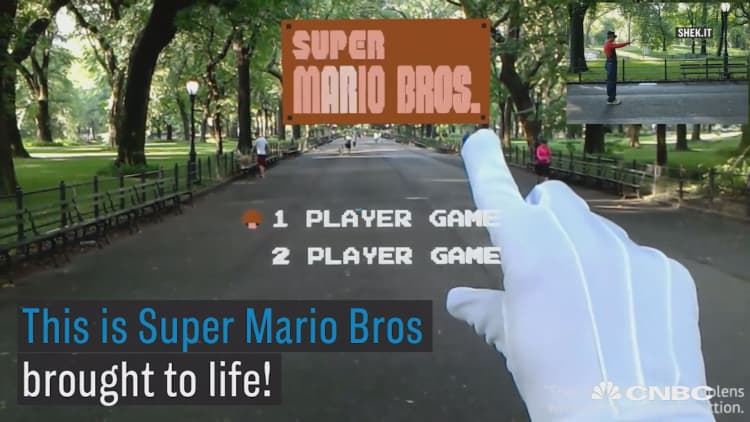More than thirty-five years ago, Nintendo debuted a video game that wiped out its competitors like a green turtle shell wiping out a string of Goombas.
In case you didn't get the reference, it's from "Super Mario Bros.," which was released in Japan on September 13, 1985. The game went on sale in North America later that year and it quickly became one of the most popular video games of all-time, eventually selling over 40 million copies for the original Nintendo Entertainment System (NES).
In fact, the game's titular character — Mario, a mustachioed plumber in overalls and a red cap — went on to become Nintendo's unofficial mascot, appearing in more than 200 different video game properties, from "Mario Kart" to "Mario Party," and making the company's large portfolio of Mario-themed games the best-selling video game franchise ever.
But, if the Nintendo game designer who first created Mario had his way, the character might never have existed — or, at least, he would have been very different.
Legendary video game designer Shigeru Miyamoto ("Donkey Kong," "The Legend of Zelda," "Star Fox") actually first created the Mario character to be the protagonist of "Donkey Kong," the 1981 arcade game where a carpenter tries to rescue his girlfriend from a giant ape who was Mario's pet. (Mario didn't become a plumber until four years later, when Miyamoto decided that Mario's profession should better match the green pipes and sewer settings of the "Mario Bros." franchise.)
Miyamoto, an artist who had been hired at Nintendo four years earlier for his skills as a toymaker, was tasked with coming up with a new arcade game to replace Nintendo's failed 1980 title "Radar Scope," according to a 2010 profile of Miyamoto in The New Yorker. Miyamoto wanted to create a game based on the iconic cartoon sailor Popeye, but Nintendo wasn't able to land the rights to those characters, so the artist had to come up with a new idea.

Instead, of a sailor, Miyamoto opted for another blue-collar profession — a carpenter, and one who sported a mustache and Mario's trademark overalls and hat. The character was originally just called "Jumpman" since he had to leap over obstacles; then, the real star of the game was Donkey Kong.
When Nintendo released "Donkey Kong" in the United States, the company's American executives felt that Jumpman needed a better name. Workers at Nintendo's Washington warehouse had started calling the character "Mario" because he resembled the property's landlord, a man named Mario Segale, according to the book "Game Over, Press Start to Continue." Miyamoto heard about the nickname and liked it, so he stuck with it.
"They started calling the character Mario, and when I heard that I said 'Oh, Mario's a great name — let's use that,'" Miyamoto told NPR in 2015.
"Donkey Kong" was extremely popular in arcades around the world, earning the game its own spot in the pantheon of classic video games. Nintendo went on develop several sequels to the original before tasking Miyamoto with breaking out the Mario character for his own game. Miyamoto created a brother for Mario (the green-clad Luigi) and the pair debuted in the 1983 arcade game "Mario Bros.," which was mainly only distributed in Japan.
Two years later, though, Mario's star exploded worldwide when Nintendo released "Super Mario Bros." as the centerpiece game for its NES home-gaming console. After its successful release, Nintendo started bundling "Super Mario Bros." with its consoles — so, if you bought the system, you got the game too — which helped further drive sales. The Nintendo NES went on to become the best-selling video game console of its generation, selling over 60 million units, according to the company.
And, while the NES gave way to the Super Nintendo console in 1991, and then the Nintendo 64 in 1996 and so on, the character Mario has endured and flourished for Nintendo for over three decades and across multiple gaming platforms and other media (including films and TV). Today, when Nintendo launches a new gaming platform, the company invariably has a new Mario game title ready to pair with it, such as 2017's "Super Mario Odyssey" for the popular Nintendo Switch (the game has sold over 10 million copies).
And, while Miyamoto may have originally had his sights set on a more Popeye-like character, Mario's eventual ubiquity is one thing the artist actually planned from the start. "My original goal was that I really wanted to use Mario in a lot of different games," Miyamoto told Time magazine in 2010.
"It's sort of common among the popular culture in Japan that a creator will take that same character and have him will appear in different manga [comics]," he says. "It's also sort of like, maybe, Hitchcock appearing in all his movies. It's sort of cool to have that character appearing here and there, whether or not they have a large role or not."
Don't Miss:
Remember these failed Apple products? They were some of the tech giant's biggest flops
Like this story? Subscribe to CNBC Make It on YouTube!


